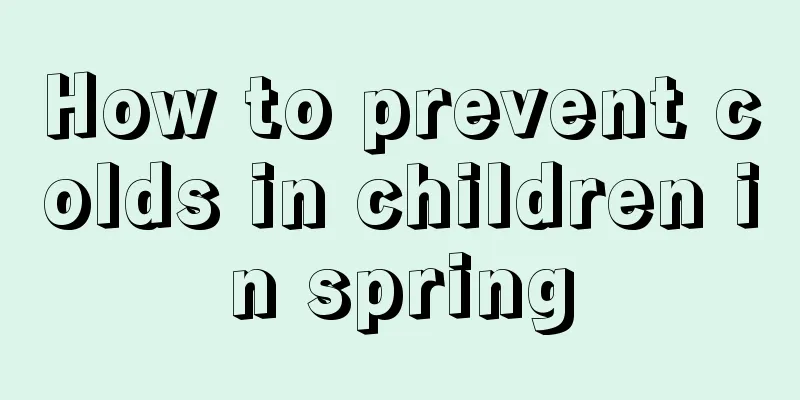What are the physical methods of cooling down children's fever?

|
As children grow up, they are very likely to develop fever symptoms caused by various diseases. Once symptoms of fever appear, it will cause serious harm to the child's health. Timely physical cooling methods can greatly alleviate the child's condition and buy time for further treatment. So, what are the physical methods to reduce fever in children? Let’s take a closer look. Method 1: Warm and wet compress Using warm water can also help dissipate heat, and it is very simple to operate Specific approach Prepare warm water, the hot water temperature should be around 30℃. Undress your baby, wet a towel, and rub your baby's body up and down with the warm towel. Change towels every ten minutes. Method 2: Ice compress Heat is mainly transferred through the exchange of heat between ice placed in large blood vessels throughout the body and the flowing blood. At the same time, it can reduce the oxygen consumption of brain cells, delay brain cell damage, and is beneficial to the body's microcirculation. Specific approach Put homemade ice cubes just taken out of the refrigerator into a plastic bag, tie it tightly, put it in 2-3 layers to prevent leakage, and then wrap it with a towel. Apply ice packs to the back of the head, forehead, armpits, neck, groin and other places where large blood vessels pass. Change it every minute until the high fever drops. The ice bag needs to be wrapped with a layer of cloth to prevent local skin frostbite. If the baby shivers, feels cold, turns blue in the face, or has purple skin in some areas, stop using the product immediately. Boy babies should be especially careful to avoid contacting the scrotum area with the ice pack. Using the prepared ice bag as an ice pillow has a good cooling effect. Method 3: Use a cooling patch Cooling patches, which are popular in Europe and the United States, have now become a common cooling product in Chinese families. When a child has a fever, just stick one on the forehead or other areas where large blood vessels run to achieve the effect of physical cooling. The reason why the cooling patch can play a cooling effect is mainly because it contains high-molecular hydrogel, which uses physical principles to concentrate heat into the gelatinous substance, and then takes away the heat through water vaporization, thereby assisting in local cooling to reduce fever. In addition, some natural medicines contained in cooling patches, such as mint and borneol, also have a certain cooling effect. Specific approach Tear open the packaging bag along the notch, take out the patch, peel off the transparent film, and apply the gel surface directly to the forehead or temple, or to the Dazhui point on the neck. 1-3 times a day, each patch can be used continuously for 8 hours. After using the cooling patch, if the body temperature remains above 38.5℃ and does not drop, you should go to the hospital for treatment in time. When applying the mask, avoid contact with hair, eyebrows, wounds, eyes or other abnormal skin areas. Method 4: Alcohol bath Alcohol can dilate blood vessels and take away a lot of heat when it evaporates. If your baby has a fever, you can use alcohol bath to help reduce the fever. This method cools down quickly, and the body temperature will generally drop quickly. Specific approach Take one part of 95% alcohol bought from the pharmacy, add two parts of warm water, stir evenly and set aside; if it is 75% alcohol, add the same amount of warm water as the alcohol. If you don't have alcohol on hand, you can also use 60° white wine instead. When using white wine, you can mix one part of white wine with 2/3 parts of water, or you can add ice cubes to increase the cooling effect. Use gauze or a small towel to wet it and wipe the baby's body, generally where there are more blood vessels, such as the neck, armpits, thighs, etc. These areas have fast blood circulation, shallow blood vessels, and are easy to dissipate heat. Apply in a certain order, from top to bottom, from left to right, using a patting method until the skin turns slightly red. Pay attention to keeping the rubbed body parts warm. Move quickly, 5-10 minutes each time. When wiping, avoid the baby's head, face, abdomen, soles of the feet, and heart area in front of the chest to avoid causing adverse reactions. I hope the above introduction to the physical cooling methods for children with fever will be helpful to parents. Children are a vulnerable group and their healthy growth must be ensured. Correctly mastering the physical cooling methods can provide emergency treatment for children with fever and play a protective role. Therefore, parents must have some knowledge about physical cooling. |
<<: What are the physical cooling methods for children?
>>: What are the symptoms of wind-heat cold in children
Recommend
What to do if the baby has red spots on his face
Taking care of a baby is something that requires ...
Is it okay for a two month old baby to sleep on his stomach?
We all know that when the baby is two months old,...
2-year-old baby's foot valgus
Many parents think that their children's unst...
Symptoms of mental retardation
In the context of eugenics and good parenting, wh...
Reasons for excessive lead in children: attention should be paid to food, clothing, housing and transportation
Now more and more children are suffering from lea...
What is the matter with the student's right shoulder pain
We know that today's students have heavy acad...
What to do if your newborn baby has loose stools
In life, diseases in babies are the most importan...
The reason why the child suddenly fainted is
Many people have experienced dizziness after stan...
Heel inversion
The phenomenon of inversion of the heels is parti...
What should children eat when they have sore throat? Introducing the correct way to eat it!
Once a child's throat becomes inflamed, there...
What time is best for children to go to bed at night?
Nowadays, many young parents are prone to late sl...
What is the reason for the child's squint?
There are actually reasons why children have stra...
What can children with poor physical fitness eat to strengthen their physical fitness?
I believe that the most headache-inducing thing f...
What to do if a child has worms in his anus
If there are worms in a child's anus, it mean...
What are the symptoms of handsomeness disease?
Many elderly people often mention handsomeness di...









